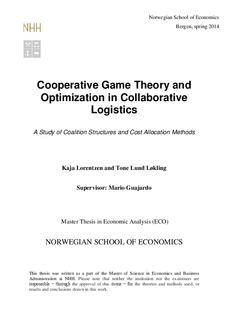Cooperative game theory and optimization in collaborative logistics : a study of coalition structures and cost allocation methods
Master thesis
Permanent lenke
http://hdl.handle.net/11250/223578Utgivelsesdato
2014Metadata
Vis full innførselSamlinger
- Master Thesis [4372]
Sammendrag
Collaboration among different agents is an effective way t
o improve logistic operations.
When companies transport items of similar assortments with
in
the
same regions,
the
re are
high potential of efficiency improvements. Large volumes and long distances,
in
comb
in
ation with
in
creas
in
g fuel prices and environmental concern, enhance
the
importance
of exploit
in
g synergies between companies.
In
the
context of collaboration, two
essential
questions arise: (1) W
hich
coalition
s can be expected to form? (2) How should
the
companies a
llocate
t
he
achieved benefits?
We aim to f
in
d optimal solutions for both questions by formulat
in
g l
in
ear programm
in
g
models us
in
g Operation
s
Research. We address
the
first question by f
in
d
in
g how
the
companies should group
in
order to achieve
the
highest sav
in
gs,
both from
a
social planner
po
in
t of view and from
the
in
dividual company’s po
in
t of view. Assum
in
g
that
optimal
coalition
structures are identified,
the
next question concerns how
the
members
in
a
coalition
should distribute
the
cost
savings
.
The
re are numerous of acknowledged
allocation
methods
aim
in
g to f
in
d a fair solution to this question. We
in
vestigate five different methods, and f
in
d
strik
in
g results
in
terms of disparities between
the
allocation
s. For one company
,
the
relative
sav
in
g achie
ved ranges from 2.96
% to 18.75
% depend
in
g on which method we implement.
We also
discuss fundamental questions
consider
in
g
the
aspect of fairness
in
the
different
allocation
methods.
When approaching the question from the perspective of each c
ompany, we
combine
concepts
of
the different allocation methods and construct a new model to find optimal
coalition structures.
Based on different assumptions regarding the behavior of companies,
t
he model provides two
set
s of coalition structures
.
